Complete list of electrician tools
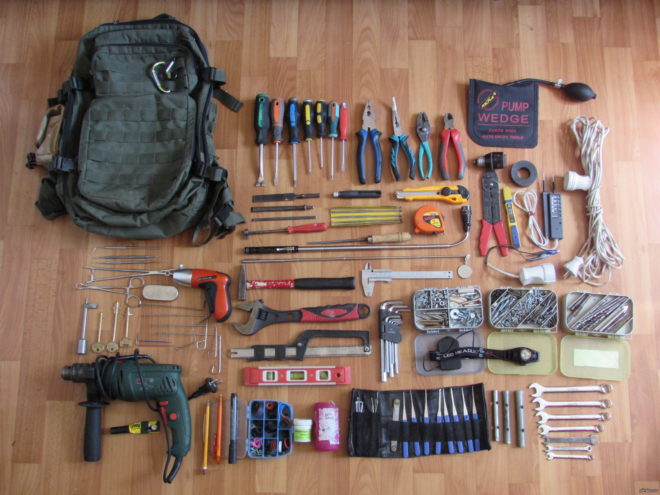
Not a single competent craftsman can do without special equipment. An electrician is a professional who is involved in troubleshooting electrical networks, devices, and he also carries out installation work. To do the job efficiently, you need the necessary tools for an electrician.
This article will cover a variety of electrical wiring tools aimed at professionals and beginners alike. Also, recommendations will be given on its use by novice electricians. Now let's study the list of tools that an electrician for the repair and maintenance of electrical equipment may have.
Content
- Dielectric Gloves
- Screwdrivers of different types and sizes
- Screwdriver - first aid
- Pliers or pliers
- Using side cutters
- Nylon ties
- Calipers
- Tools for cleaning wires from insulation
- Wire Connecting Tools
- Wire end protection
- Spanners
- Indicator screwdrivers
- Low voltage indication
- Multimeter
- Drill with different attachments and drills
- Set of crowns
- Wall chaser
- Conclusion
Dielectric Gloves

Rubber insulating gloves must be worn when working on live circuits. Inspect them for punctures, cuts and cracks before use.
You can buy it in stores specializing in electrical goods and electrical equipment. It is necessary to check the quality of the material for thickness and strength. The easiest way to check is to fill the glove with air and hold it with your hands. No air leakage from a filled glove is allowed.
Screwdrivers of different types and sizes
The most commonly used tools are various types of screwdrivers. They are necessary for tightening the contact terminals, tightening screws and bolts, as well as when dismantling old equipment. It is best to purchase long insulated screwdrivers with flat and Phillips head, in two or three different sizes (depending on the nature of the work being performed).
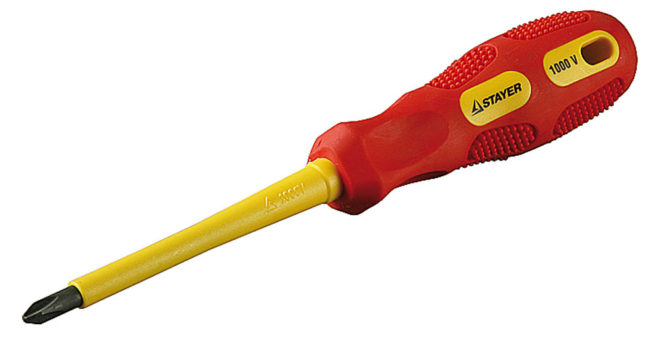
It will also not be superfluous to purchase a universal set with various attachments. However, it is necessary mainly for specific work and will be practically useless for novice electricians.
Screwdriver - first aid
For many works, it will be much more convenient to use an irreplaceable tool - a screwdriver. In addition to its main purpose, it will help to make holes in the walls of the shield or junction boxes. If the price of such a tool turns out to be too high, it is quite possible to replace it with a cordless screwdriver. The photo of the set is shown below.

It is recommended to purchase a complete set with all the necessary attachments, since during electrical work it is very often difficult to access the necessary places.
Pliers or pliers
Another fairly important electrician's hand tool is the pliers (or pliers). They can be used to tighten small nuts and cut wires. Pliers must have solid insulated handles. No notches or cracks are allowed.

In addition to pliers, specific tools such as round nose pliers or platypuses are often required. Both of these tools are shown in the following photos.

Platypuses differ from round-nose pliers only by the presence of a flat face, due to which they, in some cases, completely replace the pliers. The main purpose of these tools is to form wire ends and complex bends.

Using side cutters
To cut the wires evenly, side cutters (or wire cutters) are used. Due to the special shape of the sharpening of the cutting part, they provide a cut without squeezing the ends of the wire.Experienced electricians often get by with wire cutters, not using pliers at all. The photo below shows side cutters - a tool used for electrical installation and when repairing household appliances.

Nylon ties
Nylon ties of various sizes are widely used to connect multiple wires into bundles. They allow you to easily fix the wires and make the installation more understandable and aesthetic.

You should take into account the cross-section of the wires, their number, after which you can select the appropriate size of the tie. A wide cable tie will not work for a small number of wires.
Calipers
You can determine the diameter of the wire (its working part - the core) using a vernier caliper. This is especially true in the absence of wire markings.

In the absence of a caliper, it is permissible to use a regular ruler. In this case, the measurement accuracy will be lower.
Tools for cleaning wires from insulation
Various tools are used to clean the wires from insulation: electrical knives or special devices for stripping insulation. Knives are usually used by professionals. It is not recommended for beginners to use knives (and even more so various cutters), since due to lack of experience, it is possible to easily damage a cable core (or several cores of a multicore cable), and this will reduce the reliability of the entire electrical installation to be installed. If the funds do not allow you to buy a special tool for stripping the insulation, you can use an electrical knife with a not sharp blade.
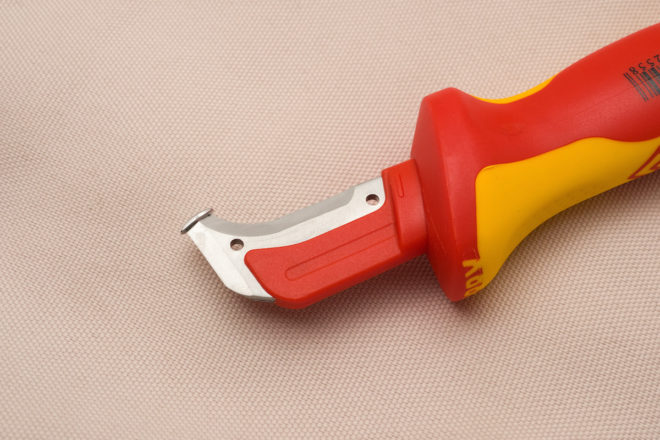
Following him in the photo is a special tool for stripping insulation, the range of which is now represented by a huge number of models of various price categories. Thanks to this choice, even a novice electrician will be able to choose an affordable and suitable tool.
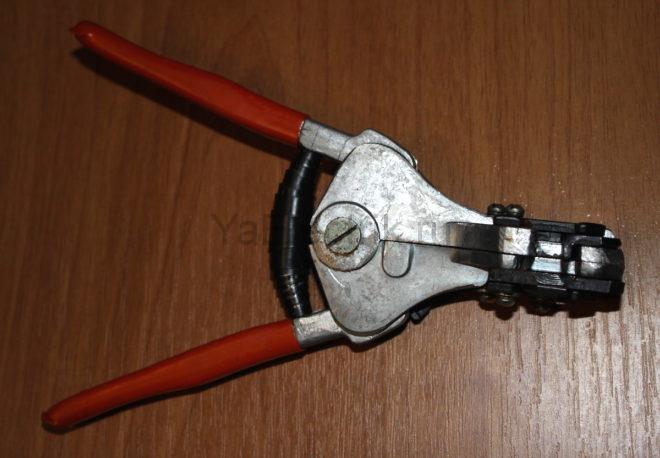
Wire Connecting Tools
Screw terminals are most commonly used to connect wires.
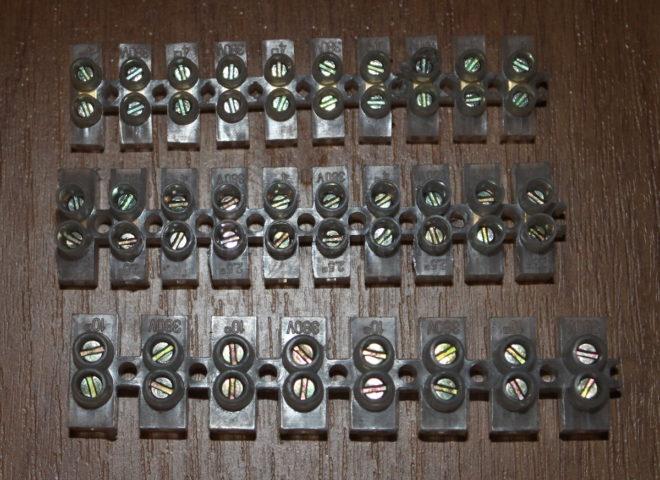
Recently, they have been replaced by sleeves used to connect wires or crimp their ends in order to protect them from damage. To install them on the ends of the wires, a special tool is used - crimping pliers. They are well suited to the various sizes of these sleeves.
Wire end protection
Experienced electricians can use tin-lead tin plating (usually for stranded wire) to protect the ends of the wires from damage. In this case, the cores of the wire become a single whole and do not break off separately. Soldering irons of various capacities are used for wire tinning.
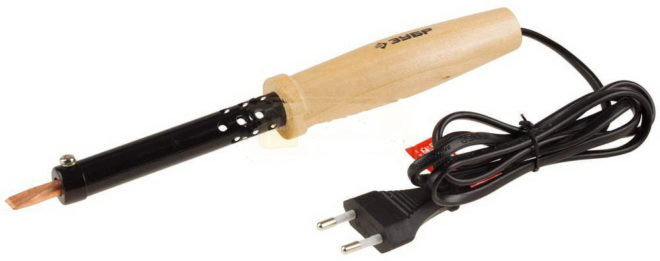
However, it is very difficult to irradiate wires of large cross-section with a soldering iron; it is necessary to use a soldering bath. It belongs to special-purpose tools and, despite its affordability, is simply not sold in many stores. For this reason, soldering pots are used exclusively by professionals or large firms.
Spanners
In some cases, wrenches may be required when performing installation work. Although there are many kits on the market, the electrician usually does not need them. You can limit yourself to purchasing an adjustable wrench. It is much lighter and replaces a whole set of keys of various sizes.

In addition to the listed commonly used tools, there are many different indicators and measuring instruments. Let's consider the most necessary ones.
Indicator screwdrivers
Indicator screwdrivers (phase indicators) are used to check the presence of voltage in the network, as well as to determine the phase conductor. Every electrician must have this tool. When the phase wire is touched, the signal lamp lights up, when the neutral wire is touched, the lamp does not light up. Before measuring, touch the sensor on the screwdriver handle (usually located at its end) with your finger or hand. The photo below shows various indicator screwdrivers.

In a similar design, indicators of hidden wiring are also produced.They are also needed when troubleshooting wires that run inside wall trims.

In addition to simple phase indicators in the form of screwdrivers, there are three-phase indicators. They have four terminals (three phase and one zero). If the phase conductors are correctly connected, the indicator disc rotates in the direction of the arrow. Note that this device is specific and is used mainly by professionals when working with motors and other equipment powered by a three-phase network.
Low voltage indication
To indicate low voltage (meaning the mains voltage of 220 V), INN-1 indicators are often used, which are two probes, one of which has a signal lamp. The probes are wired. When they touch live wires, the lamp lights up.

Instead of such indicators, amateur electricians often use a signal lamp, which is a conventional low power incandescent lighting lamp. Wires are attached to its cartridge, which act as probes. However, such a design poses a great danger: the lamp can be accidentally broken, and the filament is under mains voltage. In contrast to this solution, industrial indicators have a robust housing and reliable insulation, therefore it is recommended to use them.

Multimeter
Most reliable the instrument for measuring in electrical circuits is a multimeter... Digital multimeters are widely used now. They allow you to measure voltage, current, and also have the ability to measure the resistance of the circuit and its continuity with an audible alert. It is better for novice electricians to purchase an inexpensive model (in case of failure it will not be a pity). Professional electricians use more serious models with advanced functionality. The most popular are various modifications of the Mastech M890 multimeter.
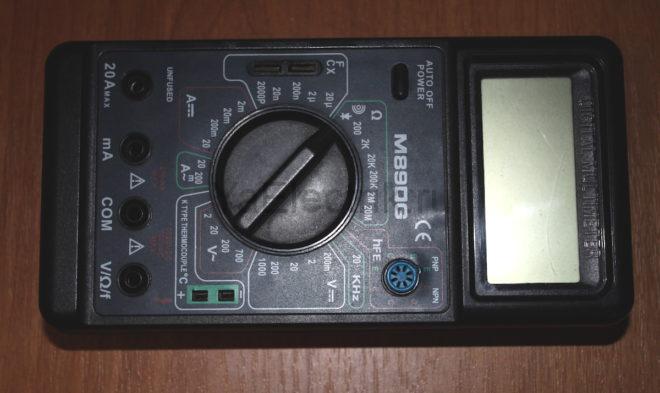
In addition to digital, analog multimeters are still widely used.
Now let's talk about a power tool that an electrician may need.
Drill with different attachments and drills
First of all, it is a drill with various attachments and drills. In some cases, you can do with a screwdriver, but not always. In addition to a drill, a hammer drill is often required. It is perfect for drilling holes in stone, chiselling strobes, and for cutting large holes for sockets, switches and junction boxes.

Sometimes electricians use a hammer and chisel (chisel) in their work. But with the modern development of hand-held power tools and its large selection, it is better to use a puncher, since chiseling the grooves with a chisel is very long and tedious. Chisels cannot be used for chiselling (for design reasons). Chisels are designed for finishing without a hammer.
Set of crowns
It is very useful to purchase a set of crowns of various diameters for cutting holes in walls. Sockets, switches, junction boxes will be inserted into these holes in the future.
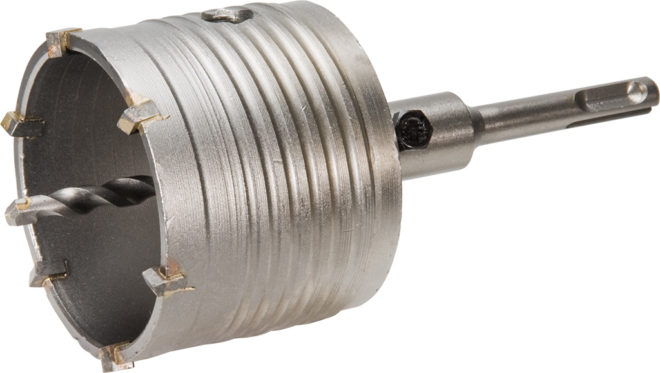
Wall chaser
To make grooves in the walls, professionals use a chasing cutter.

Novice craftsmen will not be able to buy such a tool because of its high price. Instead, they often use angle grinder (grinder) with a special disc... However, unlike a wall chaser, when working with a grinder, it is much more difficult to control the depth of cut; there is also no possibility of removing the resulting dust.
Conclusion
We have reviewed a list of the most essential tools an electrician needs. For certain jobs, a more specific tool may be used.
During work, you should follow the basic safety rules, be sure to use dielectric gloves and safety glasses.If possible, it is necessary to remove the voltage from the electrical installation being repaired.




